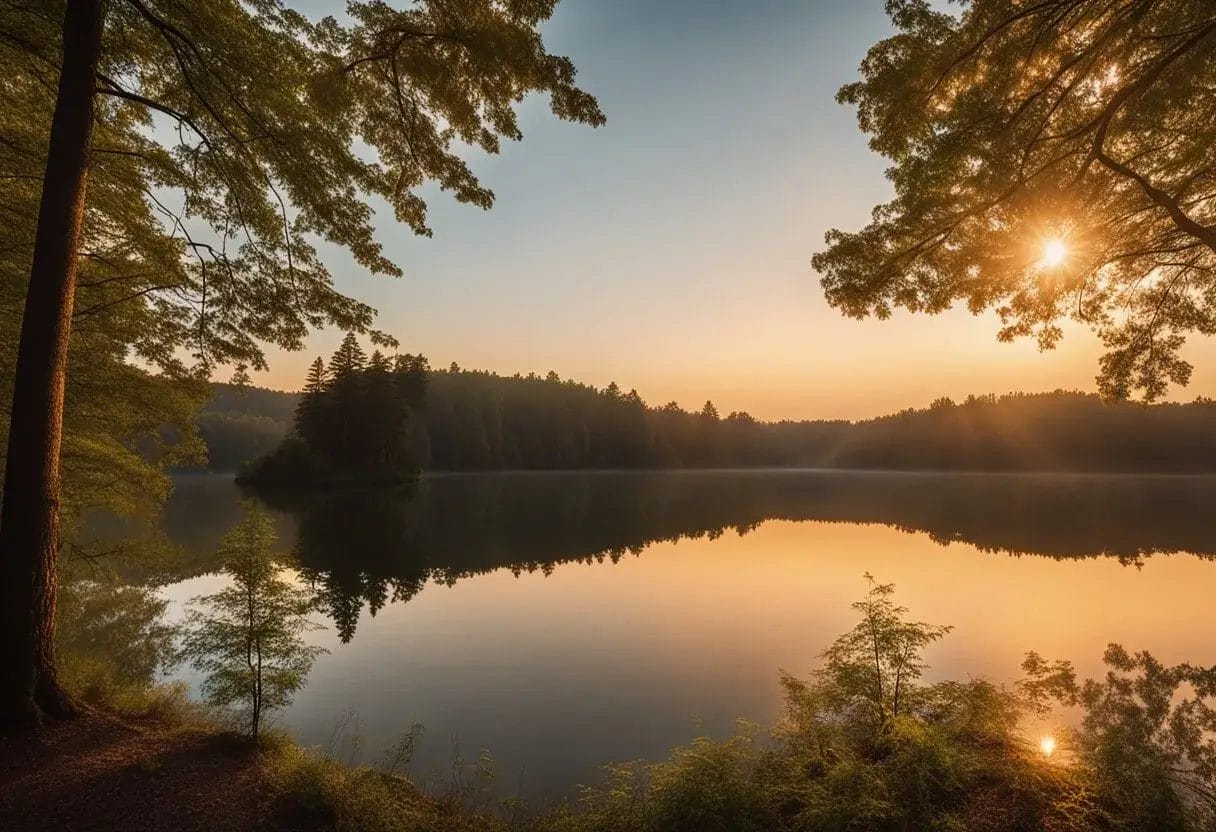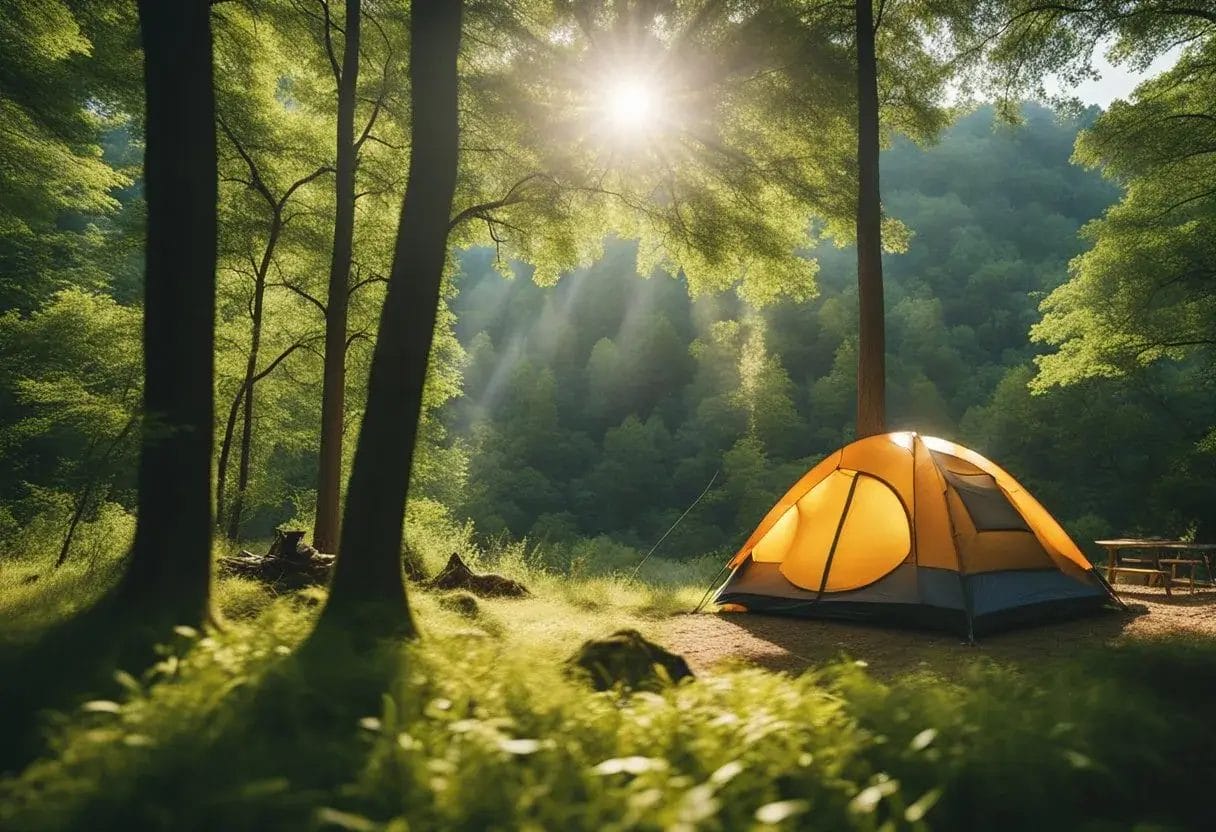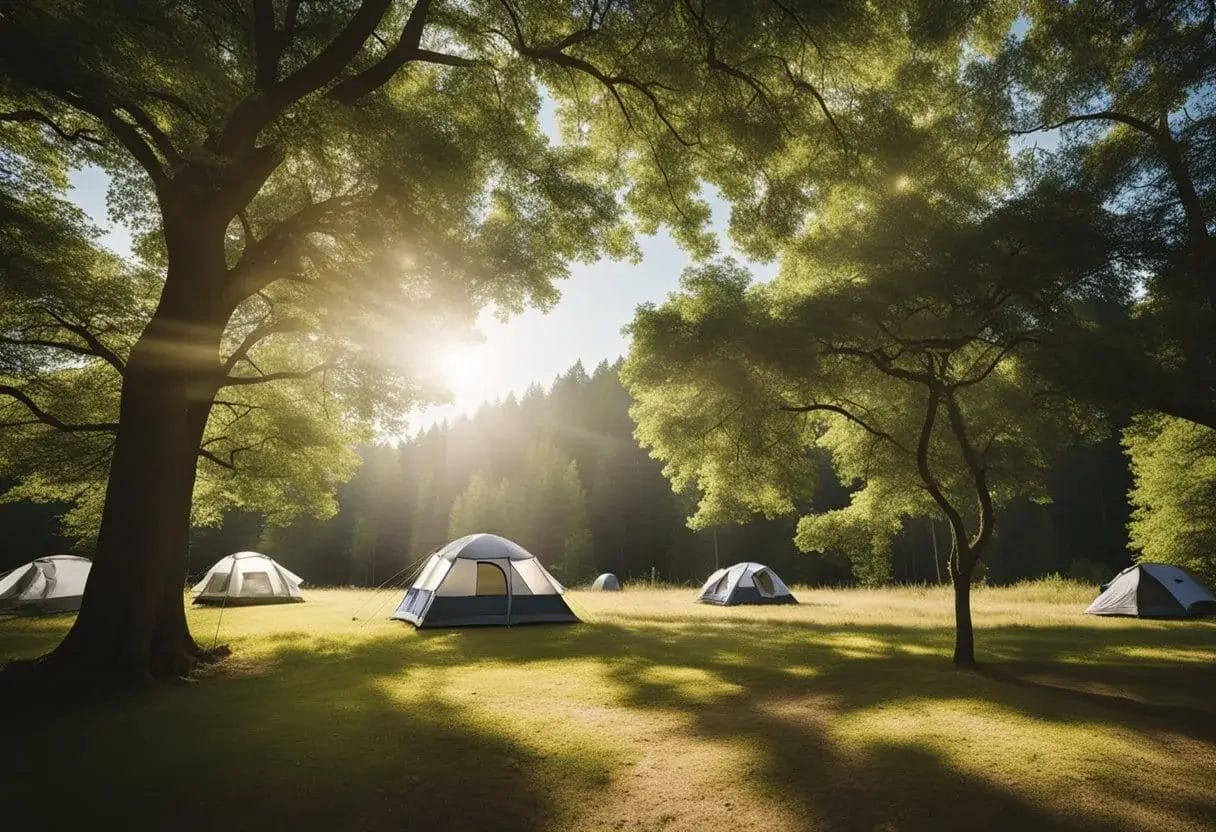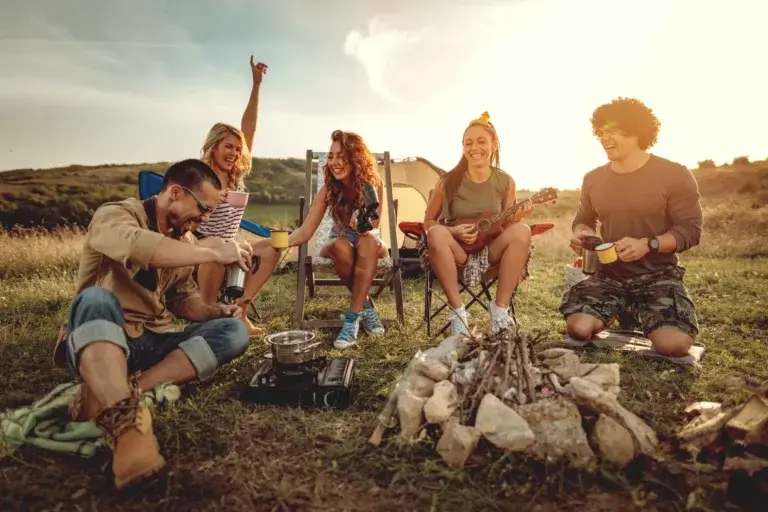Best Camping Weather: Discover Nature’s Ideal Glamping Conditions
Camping is an activity that brings us closer to nature and allows us to unwind from the daily grind. Selecting the best camping weather will make a huge difference in planning a successful trip. Knowing the ideal camping conditions can lead to a more enjoyable and comfortable experience, ensuring that we can focus on the beauty of the great outdoors without worrying about extreme temperatures or inclement weather.

We might prefer mild temperatures and low humidity for daytime activities like hiking, bicycling, and kayaking. Overnight lows between 40-60°F ensure a comfortable night’s sleep during our camping adventures. However, we should always be prepared for unexpected weather changes and pack accordingly. Tailoring our camping gear and selecting the appropriate clothing are essential aspects of having a successful and enjoyable camping trip.
Key Takeaways
- Choose camping weather with mild temperatures and low humidity to enhance comfort during daytime activities.
- Be prepared for unexpected weather changes by packing appropriate gear and clothing.
- Prioritize safety and comfort by understanding essential camping weather factors before embarking on a trip.
Table of Contents
Disclosure: This post contains affiliate links and might earn us a small commission if you make a purchase at absolutely no extra cost to you. Pawsome, right?!
Best Camping Weather – Understanding Camping Weather Essentials

Deciphering the Ideal Temperature for Comfort
When planning our camping trips, one of the key factors we need to consider is the temperature. After all, we want to make sure that we’re neither sweating in the sweltering heat nor shivering in the bitter cold. A general rule of thumb is that the ideal camping weather is between 50°F (10°C) and 80°F (27°C). However, remember that perfect camping weather may vary depending on our personal preferences and the activities we plan on doing. We personally love cold weather camping because there are virtually no other people around and we get to enjoy prime camping spots to ourselves. We have friends who refuse to camp during the winter months because they just don’t care for cold temperatures.
Additionally, the type of gear we bring can significantly impact our comfort during both day and night. For instance, a well-insulated warm sleeping bag is our pal when temperatures drop at night, ensuring we snuggle up cozily without turning into popsicles. Always be prepared to adapt to unexpected weather conditions by bringing appropriate layers and gear.
Preventing the Perils of Precipitation
Nothing puts a damper on a camping trip quite like rain, but let’s not let it rain on our parade! Knowing the precipitation forecast will help us better prepare our camping equipment, such as packing rain gear or adjusting our camping schedule accordingly. Camping weather forecasts can be our best friend for detecting the chances of our campsite turning into a temporary waterpark.
If heavy rainfall is in the forecast, we should consider packing waterproof clothing and tarps and making sure that our tent has solid rain protection. Also, don’t forget that trails can turn muddy after a downpour, and camping areas might be flooded. Keep an eye on the skies, folks!
Wind: The Invisible Game Changer
While we tend to focus on the sun and rain, we mustn’t underestimate the power of the breeze—even the gentle, whispering kind! Wind can turn an otherwise lovely camping trip into a nerve-racking battle against unexpected gusts.
Always pay attention to wind speed when checking the weather forecast, as it can significantly affect our camping experience. The Beaufort wind scale gives a rough estimate of what to expect, with higher numbers indicating stronger winds. Keep this in mind when choosing our campsite location and setting up our trusty tents—nobody wants a surprise sail-away tent situation!
Remember, camping weather goes beyond the temperature. By understanding the essentials like precipitation and wind, we can better prepare and ensure that our experience in the great outdoors is comfortable and memorable (in a good way!).
Selecting the Perfect Camping Season
Summer Smiles: Warm Weather Camping
Ah, summer, the time when we can finally shed our layers and enjoy the great outdoors. With mild temperatures ranging from 60-80°F during the day and 40-60°F at night, summer camping is perfect for hiking, bicycling, kayaking, and fishing. Sunny days and warmer weather make for good news if colder weather isn’t your thing. Just remember to pack sunscreen and hats, and stay hydrated!
The Beauty of Fall Camping
As the leaves change into vibrant colors, fall is an excellent time to immerse ourselves in nature’s beauty. Late June to early September is the best time to go camping for mostly dry weather. Just imagine cozy campfires and hikes with the stunning backdrop of fall foliage! Meanwhile, cooler temperatures mean fewer bugs, which is always a welcome change. Be sure to bring warmer layers for chilly evenings, and don’t forget the marshmallows for s’mores!
Winter Wonderland: Embracing the Cold
Winter camping might not be everyone’s cup of hot cocoa, but snow-covered landscapes will steal our hearts. With proper gear and clothing, we can check out the joys of winter camping. Snowshoeing, skiing, and other winter-based outdoor activities might become our new favorites. Also, bonus, campgrounds are less crowded during this time! If you prefer to camp with fewer people around cold-weather camping may just be worth trying out. So pack our warmest sleeping bags and thermal layers, and let’s cozy up in a frosty winter wonderland.
Spring Into Camping: A Reawakening
Spring is all about renewal and reawakening – so what better time than to dust off our tents and embrace the great outdoors? As temperatures warm up and the world comes back to life, it becomes an excellent opportunity to explore nature’s beauty, with blooming flowers and chirping birds. Be sure to remember the rain gear and plan for possible fluctuating temperatures, as spring camping can be unpredictable. A good rain jacket can make an otherwise soggy day much better! But hey, that’s part of the adventure, right?
No matter when we decide to pitch our tents, there’s always something magical awaiting us in the great outdoors. Happy camping!
Choosing Your Camper’s Paradise
Evaluating the Campsite
When choosing the perfect campsite for our outdoor adventures, there are several factors to keep in mind. The ideal campsite should offer easy access to hiking, fishing, and stargazing opportunities, depending on our preferences. As we all know, weather plays a significant role in our camping experience. That’s why, when planning our camping trip, we should aim for weather with daytime highs of 72-78F and evening lows not below 55F, avoiding rain and high winds whenever possible.
Some of the essential features we can expect from a well-suited campsite include:
- Scenic views: For a memorable experience, we want a campsite that boasts beautiful surroundings.
- Sheltered spots: To enhance our comfort, look for well-protected areas or natural windbreaks within the campsite.
- Level terrain: Believe us when we say that pitching our tent on a flat area can make the world of a difference for a good night’s sleep.
- Proximity to water: Ideally, our campsite should be near a water source for easy access to drinking water and fishing opportunities.
If you’ll be bringing a furry friend to a campground, remember to make sure that it’s dog-friendly first! We have a helfpul guide for camping with dogs here.
Outdoor Adventures Beyond the Tent
Our perfect camping trip doesn’t always have to be confined within the campsite. In fact, exploring the great outdoors is what makes camping so thrilling in the first place. One fantastic way to amp up our outdoor adventures is by venturing into the backcountry for some rejuvenating travel experiences. Here are a few activities that can take our camping trip to the next level:
- Hiking: From gentle nature walks to challenging climbs, there’s a trail out there for everyone. Just remember to pack proper footwear, weather-appropriate clothes, and plenty of water. If you hike with your dogs like us, you may enjoy this article!
- Fishing: Whether we’re novices or seasoned anglers, there’s something magical about reeling in your catch amidst the tranquility of nature. Just keep track of local fishing regulations, and don’t forget our fishing license.
- Stargazing: One of the most underrated pleasures of camping is gazing at the mesmerizing night sky. Check out The Ultimate Guide to RV Camping for some stargazing tips, and don’t forget to pack a telescope or binoculars.
In conclusion, every camping adventure starts with choosing the right campsite and embracing the various outdoor activities that make our experience truly unforgettable.
Camping Gear for Every Forecast
Staying Dry with the Right Waterproof Gear
Let’s face it: nobody likes to be wet and miserable while camping. So, it’s a good idea to invest in some high-quality waterproof gear to keep us dry in case the weather takes a turn for the worse. Waterproof gear can range from rain jackets and pants to covers for our backpacks and even waterproof shoes and socks. Having the right gear ensures we’re ready for anything Mother Nature throws our way.
Layers on Layers: Insulation for the Chilly
Brrr! When temperatures drop, rely on extra layers for insulation. Layering has a few key components to get just right:
- Base layers: These are the clothing items that sit snug against our skin and should be made of moisture-wicking material to keep us feeling dry and warm.
- Mid-layers: This layer adds some extra warmth to our camping wardrobe. Think fleece jackets or vests.
- Insulating layers: These are the puffy jackets, sometimes filled with down or synthetic insulation, that keep us cozy during freezing nighttime temperatures. Don’t forget insulated gloves and socks!
It’s better to have a few layers and remove them if we get too warm than to be shivering and miserable while trying to enjoy the great outdoors.
Battling Breezes: Gear for Windy Conditions
No one likes to have a gust of wind attempt to steal the marshmallows from our s’mores! To prepare for windy conditions, we can use 4-season tents with sturdy poles and a full-coverage fly, creating a solid barrier against strong gusts. Camping in a spot with natural windbreaks, like trees or some big ol’ rocks, can also help.
Investing in windproof gear, such as jackets and pants with wind-resistant materials, helps to shield us from those blustery breezes while keeping us toasty. Don’t forget the importance of mesh-free tents with a vestibule, where gear storage gets a wind-free zone, and wind-induced sand and dust attacks are minimized.
With the right gear and preparation, we can confidently tackle any weather forecast, ensuring our camping trips are filled with fun, laughter, and unforgettable memories rather than becoming soggy or shiver-filled misadventures! Remember, friends, we are in this together! Let’s show Mother Nature what we’re made of!
Safe and Sound: Maximizing Camping Safety
Protecting Yourself from the Elements
When we’re out camping, it’s essential to protect ourselves from the elements to maximize our enjoyment and stay safe. It’s not just about sun and rain; we must also consider temperature fluctuations and the ever-changing weather. So, let’s grab our favorite sunscreen and gear up!
We recommend applying a broad-spectrum sunscreen with an SPF of at least 30 to protect our skin from harmful UV rays. Reapply it every two hours or more often if we’re sweating or swimming.
To stay comfortable in various weather conditions, we should wear layered clothing. This way, we can easily add or remove layers as needed. Opt for moisture-wicking materials to keep us dry, and don’t forget a waterproof jacket to stay dry during unexpected showers or morning dew.
Quick list for weather protection:
- Sunscreen: Broad-spectrum, SPF 30 or higher
- Clothing: moisture-wicking, layered, and waterproof
Weather Hazards: Staying Alert and Prepared
Let’s face it: Mother Nature can be unpredictable sometimes! Nonetheless, it’s our duty to stay vigilant and prepared for any potential hazards while camping. Some unpredictable weather conditions we might encounter include heavy rain, thunderstorms, and extreme heat.
To avoid a wet and miserable campsite, we should check the weather forecast regularly before and during our trip. If storms are predicted, we can take extra precautions by choosing a well-drained camping spot and securing our tents with sturdy lines and stakes.
In case of extreme heat, we need to remember to stay cool by seeking shade, wearing loose, light-colored clothing, and staying hydrated. We should always watch the weather and be ready to adapt our plans if needed to ensure a safe and sound camping experience.
Stay alert, my fellow campers, and let’s make the most of our time outdoors while staying safe and sound!
Ensuring Comfort and Fun Regardless of Weather
Pitching the Perfect Tent
When it comes to camping, we can’t predict the weather, but we can control how we set up our cozy abode. Let’s dive into the art of pitching the perfect tent to ensure a fantastic camping experience, rain or shine.
- Location, location, location: Look for a spot with natural windbreaks and slightly higher ground. It’ll keep our tent dry and help us catch those lovely sunrises and sunsets.
- Don’t skip the tent stakes: Securing our tent with the right tent stakes keeps it anchored in strong winds and prevents unwanted midnight tent-flapping.
- Ventilate: We can’t emphasize this enough! A well-ventilated tent reduces condensation and keeps us comfortable.
Keeping Cozy: Camping Comfort Hacks
Brace yourselves, campers! We’re spilling our secrets to a cozy, snuggly camping night, regardless of the weather.
- Layer up, buttercup! No matter the temperature, dressing in layers is key to staying warm and comfortable. The right clothing includes moisture-wicking materials like wool or synthetic fabrics.
- Did someone say hot water bottle? We did! Slip one of these babies into your sleeping bag to keep those toes extra toasty. Just be sure to use a leak-proof bottle.
- Hello, R-Values! Keep an eye on the R-Value of your sleeping pad. A higher number means more warmth for us during those chilly nights.
Enjoy these tips, fellow campers. With the perfect tent pitch and our super-secret comfort hacks, we’ll have a great time regardless of what Mother Nature brings!
Packing Smart: Key Camping Accessories

Lightweight and Functional: The Essentials
When it comes to camping, we all know that the key is to pack smart. That means choosing lightweight, functional, high-quality gear that offers the best value for our backpacking adventures. Whether we’re setting out for a weekend trip or preparing for winter camping, it’s crucial to have the right accessories to keep us comfortable and safe.
One essential item for any camping trip is a quality tent. Look for one that’s portable, easy to set up, and has good ventilation. For instance, Marmot Limestone and Nemo Aurora Highrise tents are great options for different group sizes. Remember, the tent is our home away from home, so make sure it’ll keep us cozy and protected in various weather conditions.
Next on our list of essentials is a sleeping bag and pad. A good night’s sleep is crucial after a day full of outdoor activities. Choose a sleeping bag that’s appropriate for the expected temperatures, and make sure the pad has good insulation and cushioning.
When it comes to clothing, materials and functionality are crucial. Opt for moisture-wicking, quick-drying, and insulating fabrics like merino wool or synthetic. Remember to pack in layers for maximum adaptability to changing conditions:
- Base layer: Moisture-wicking, lightweight fabrics
- Mid-layer: Insulating materials, such as fleece or down jackets
- Outer Layer: Waterproof, breathable, and wind-resistant shells
Our backpacks also play an important role in our camping experience. We should look for packs with numerous storage pockets to help us organize our gear and easily access essentials when we need them. Additionally, make sure the backpack is comfortable to wear, especially if we’re planning a longer hike.
Last but not least, don’t forget about the little things that can make a big difference in our outdoor experience. Bring portable cooking gear like a Weber Q12 grill, collapsible bowls, and utensils. Pack handy gadgets like a Luminoodle for lighting up our campsite and a multi-tool for any quick fixes that might come up.
By packing smart and prioritizing lightweight, functional gear, we can maximize our enjoyment and minimize any hassle during our next camping adventure. Just remember: when in doubt, less is more. Keep it simple, and let Mother Nature do the rest.
PIN IT FOR LATER!
Frequently Asked Questions

What’s the ideal temperature range to set up camp and enjoy the great outdoors?
The perfect temperature range for camping would be between 50°F and 70°F (10°C and 21°C). In this range, you’ll be able to enjoy various outdoor activities without breaking a sweat or shivering. However, preferences may vary, and some of us may enjoy camping in different climates with the right gear and preparation.
How should one dress to stay comfy while camping in that tricky 60-degree weather?
When camping in 60-degree weather, it’s essential to dress in layers so it’s easy to stay comfortable as temperatures change. Start with a moisture-wicking base layer, add an insulating middle layer, and finish with a wind-resistant and waterproof outer layer. Don’t forget a hat, gloves, and warm socks to keep those extremities cozy!
Is there a temperature where camping goes from fun to sunburns and sweat?
Camping in extreme heat can lead to sunburns, dehydration, and overheating. It’s generally recommended to avoid camping in temperatures above 85-90°F (30-32°C) if possible. When camping in high temperatures, stay hydrated, wear sunscreen, and seek shade during peak sun hours. Wide-brimmed hats can help keep the sun off of our heads and shoulders. A portable fan can also help us get a better night’s sleep in hotter temperatures.
Cuddle up or strip down: what’s the best sleeping bag for a balmy, tropical night under the stars?
For balmy, tropical nights, we recommend using a lightweight sleeping bag with a temperature rating of around 60°F (15°C) or higher. You could also consider using a sleeping bag liner or a light blanket instead of a traditional sleeping bag.
Can you really rough it in 50-degree weather, or is that when you break out the woolly socks?
We can still enjoy camping in 50-degree weather as long as we’re prepared. This is indeed a time to break out those woolly socks, along with warm clothing and a sleeping bag rated for colder temperatures, like 23°F (-5°C) or lower. Just layer up and pack extra blankets to stay warm and cozy.
When tenting it, at what point does the cold make your sleeping bag beg for mercy?
The cold becomes problematic when the temperature drops below your sleeping bag’s temperature rating. Ensure you have a three-season tent and a sleeping bag rated for the specific temperatures you expect to encounter. Knowing the weather forecast and being prepared with the right gear will ensure a comfortable night’s sleep, even in more frigid conditions.








